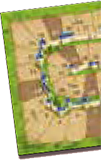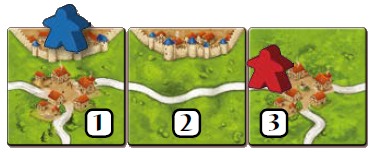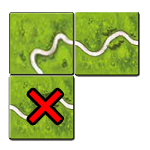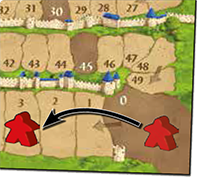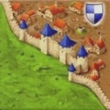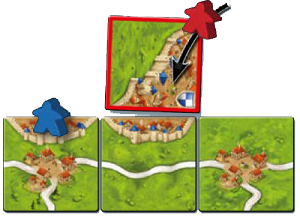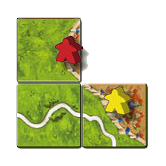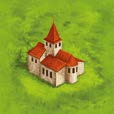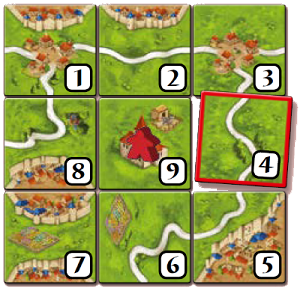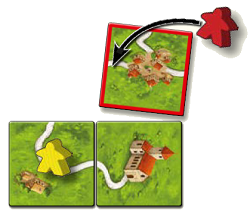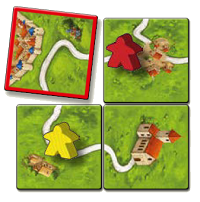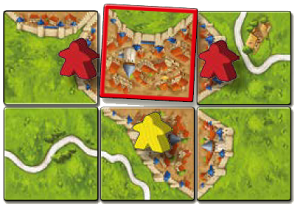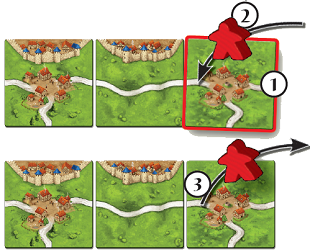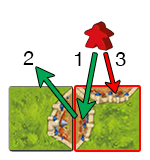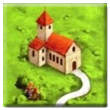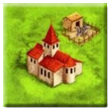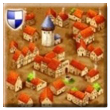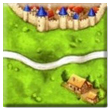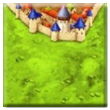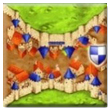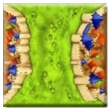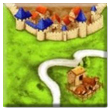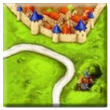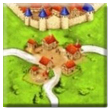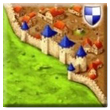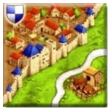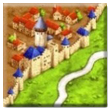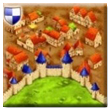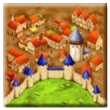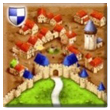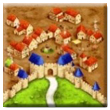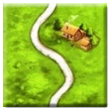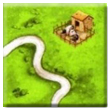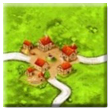User:Paloi Sciurala/NuC
| File:NuCfan Tile 06.jpg | You are reading the rules for this tile design. | File:NuCfan Tile 27.jpg |
| If your tiles look like this, you have regular Carcassonne tiles. |  |
| If your tiles have a different design, then choose a game from Spin-offs. |  |
{{#DISPLAYTITLE:Nuts under Carcassonne: Base game}}
wallnut plasezi ori 2 nucă, plasezi nucă când plasezi cartonaș cu pădure, chestnut plasezi, hazelnut muți veverițe pe el, de ajustat număr de veverițe, de văzut exact ce se întâmplă când iei nucă (poate doar atunci ai voie să pui veveriță?)
General info and comments
Spin-off by Paloi Sciurala.
GO NUTS!
Components and setup
Components
- 90 normal land tiles depicting grasslands, paths, chestnut trees, hazelnut trees, walnut trees, forests, and mushroom groups.
- 1 start tile.
- 80 nut tokens.
- 1 scoreboard.
- File:NUc Scoreboard.jpgScoreboard
- 6 wooden magpies, one in each of the following colors: red, grey, brown, black, white, and orange.
- File:Nuts under Carcassonne Nuts-tokens Feature.jpgThe six magpies
- 90 squirrels, 15 in each of the following colors: red, grey, brown, black, white, and orange.
Preparation
Shuffle all 90 normal land tiles, and place them facedown in stacks that are easily accessible to all players.
Place the start tile in the middle of the table and place 1 nut token to ever side of the start tile.
Place the scoreboard to the side of the playing area. Place the score markers (the magpies) next to it.
Each player receives 1 nut token. The rest of the nut tokens are placed next to the scoreboard.
Depending on the number of player, each player receives squirrels.
- If there are 2 players, each player chooses 3 colors and takes all of the squirrels in that color.
- If there are 3 players, each player chooses 2 colors and takes all of the squirrels in that color.
- If there are 4 players, each player chooses 1 color and takes all of the squirrels in that color.
- If there are 5 players, each player chooses 1 color and takes all of the squirrels in that color.
- If there are 6 players, each player chooses 1 color and takes all of the squirrels in that color.
Only 1 magpie is placed on the scoreboard per player. The unused squirrels and magpie do not take part to the game.
Overview and object of the game
Players take turns placing land tiles, expanding the savanna and discovering bush, animal trails, and baobab trees. You place meeples in the bush or on animal trails and complete them to score points for the different animals present, and lay meeples on baobab trees to draw new animal tiles. Animal tiles can score additional points or can be used to dig watering holes in the savanna. Players score points throughout the game as well as at the end of the game. The player with the highest score after final scoring wins.
Gameplay
A game of Carcassonne is played in clockwise order. Starting with the youngest player, [1] [2] the current player does the following actions in the order listed below, after which it is the next player's turn, and so on and so forth. First, we'll give you a brief description of the actions you have to do during one of your turns. These actions will be detailed as we present the roads, the cities, and finally the monasteries. So what are these actions?
1. Placing a tile
| The player must draw exactly one land tile from a stack and place it faceup adjacent to any tile already on the board to continue the landscape. [3] |
The roads
1. Placing a tile
You draw the depicted tile with three road segments starting from a village. You must place it in such a way that it continues the existing landscape (the tiles already in play). In the rare case that a tile cannot legally be placed anywhere, and all players agree, it is removed from the game, and the player draws another. [4] [5]
2. Placing a meeple as highwayman
After placing the tile, you may place a meeple as a highwayman on one of that tile’s road segments, but only if the road is unoccupied by another highwayman.
In our example, since the road is not yet completed, no scoring occurs (see action 3) and play moves on to the next player.
The next player draws a tile that he/she places to continue the landscape. They may not place a meeple on the road to the right since your highwayman is already present on that road. Instead, they choose to place their meeple as a knight in the city segment of that tile.
3. Scoring a road
When both ends of a road are closed, that road is completed and scored. The end of a road is closed when it meets a village, [6] a city, a monastery, or it loops onto itself by meeting the other end. [7]
![]() Question: Can a road end in nothing?
Question: Can a road end in nothing?
Even though it is your opponent that placed the tile, this still completes your road. How many points do you score? When scoring a road, each tile of that road grants you 1 point. Here, since you scored a road that is made out of 3 tiles, you score 3 points.
It is now time to note your score. You keep track of your score with the meeple you placed on the scoreboard before starting the game. Continuing our example, you move it forward 3 spaces to show that you’ve scored 3 points. Note: if your score passes 50 points, lay down your scoring meeple to show your 50+ points.
After scoring, return any meeples that occupy the road that was just scored to their owners' supply.
We’ve already seen the most important parts of the game. Now, we will further expand on those actions by showing you how they apply to the other features, namely the cities and the monasteries:
The cities
1. Placing a tile
2. Placing a meeple as a knight
Then, you see if there is already a meeple as a knight in the city. Here, there isn’t, so you can place one of your meeples as a knight in this city.
3. Scoring a city
Let’s continue our example and assume that a few turns have passed. You now draw this tile that you place to continue your city. Since the tile you’ve placed completes a feature (here, the city), it must now be scored. A city is completed when it is surrounded by walls and there are no gaps inside the city. Since you have a meeple in the completed city, you are the player to score it.
Each tile in a completed city is worth 2 points. In addition, each coat of arms is worth 2 more points. [8] For this city, you score 8 points! As usual, the meeple that was in the scored feature returns to your supply.
The monasteries
1. Placing a tile
2. Placing a meeple as a monk
3. Scoring a monastery
A monastery is completed when it is surrounded by tiles. During scoring, the monastery is worth 1 point per tile that completes it (including the monastery itself).
By placing this tile, you complete your monastery. It earns you 9 points and allows you to take your meeple back.
We have already seen most of the rules for Carcassonne. There are only a few points left to see, but first, here is a summary of what we’ve seen so far:
Summary
1. Placing a tile
- You must place your drawn tile in such a way that it continues the landscape and the illustration.
- In some very rare cases, it may be impossible to place the tile. In those cases, simply return the tile to the box and draw a new one. [4]
2. Placing a meeple
- You may place a meeple on the tile you’ve just placed.
- You may not place a meeple in a feature where there already is at least one other meeple, including one of yours.
3. Scoring a feature
- A road is completed when both ends lead to a village, a city, a monastery, or the road forms a loop. Each tile in a completed road is worth 1 point.
- A city is completed when it is surrounded by walls and there are no holes inside the city. Each tile in the completed city is worth 2 points. Each coat of arms in the completed city is worth an extra 2 points.
- A monastery is completed when it is surrounded by 8 tiles. Each of the monastery’s tiles (the 8 surrounding tiles and the one with the monastery itself) is worth 1 point.
- Scoring always occurs at the end of a player’s turn. At that moment, each player with a meeple in a scored feature earns points. [11]
- After each scoring, return the scored meeples to their owners' supply.
- If there are multiple meeples in a single scored feature, the player with the most meeples is awarded full points and all other players receive nothing. When more than one player have the most meeples in a scored feature, the tied players all score full points.
Game end and final scoring
The game ends as soon as a player can no longer draw and place a landscape tile. [12] Then, players proceed to a final scoring, after which the winner will be known.
Once the game is over, all meeples still in play are scored:
- Each incomplete road is worth 1 point per tile, just like during the game.
- Each incomplete city is worth 1 point per tile and 1 point per coat of arms, which is only half the points.
- Each incomplete monastery is worth 1 point plus 1 point per adjacent tile, just like during the game.
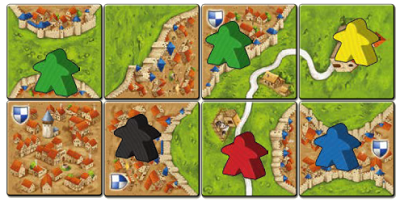
- Left city: Green is the only one to score 8 points (5 tiles and 3 coat of arms). Black does not score any points since Green has the most meeples in this city.
- Monastery: Yellow scores 4 points for this incomplete monastery (3 points for the adjacent tiles and 1 point for the monastery itself).
- Right city: Blue scores 3 points for this incomplete city (2 tiles and 1 coat of arms).
- Road: Red scores 3 points for this incomplete roads (3 tiles).
Once the final score is known, the winner is the player with the most points.[13]
Special cases
Many meeples on the same road
Many meeples in the same city
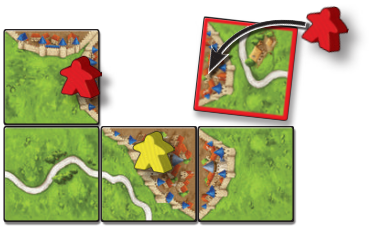
Use a meeple, score a feature, and get the meeple back
You can place a meeple in a feature you just completed, immediately score it, and then return the meeple to your supply.
To do so, follow these steps: [14]
__ 1. Place a tile, completing a feature (such as a road, city, or monastery).
__ 2. Place a meeple as a highwayman, knight, or monk on the feature you just completed.
__ 3. Score the completed road, city, or monastery and return the meeple to your supply.
![]() Question: There is a situation that puzzles us. If a player draws a tile with two city segments and completes a small city, earning 4 points, can he or she then deploy a meeple to a new city segment in the same turn?
Question: There is a situation that puzzles us. If a player draws a tile with two city segments and completes a small city, earning 4 points, can he or she then deploy a meeple to a new city segment in the same turn?
Tile distribution
Footnotes
For Icons explanation and licensing please visit Icons page.
- ↑
 The ZMG rules of the base game mention the "first player" without explaining how it is decided. However, the
The ZMG rules of the base game mention the "first player" without explaining how it is decided. However, the  Big Box 6 rules are re-aligned with the HiG rules and indicate the first player is the youngest one.
Big Box 6 rules are re-aligned with the HiG rules and indicate the first player is the youngest one.
- ↑
 It is common practice to choose starting player at random. More on this in house rules section.
It is common practice to choose starting player at random. More on this in house rules section.
- ↑
 A newly placed land tile must fit the adjacent terrain on all edges! During placement it is not enough to look for only one side that fits.
A newly placed land tile must fit the adjacent terrain on all edges! During placement it is not enough to look for only one side that fits.
- ↑ Jump up to: 4.0 4.1
 Alternatively, if legal, the player could place the abbey tile (
Alternatively, if legal, the player could place the abbey tile ( Exp. 5 - Abbey & Mayor) instead of drawing another tile. (1/2013)
Exp. 5 - Abbey & Mayor) instead of drawing another tile. (1/2013)
 By extension, other tiles in the player's supply could be chosen: a German castle (
By extension, other tiles in the player's supply could be chosen: a German castle ( Castles in Germany) or a Halfling tile (
Castles in Germany) or a Halfling tile ( Halflings).
Halflings).
- ↑
 If drawing tiles out of a bag, a tile that cannot be placed could be returned to the bag for later use.
If drawing tiles out of a bag, a tile that cannot be placed could be returned to the bag for later use.
- ↑
 Village is a little set of red roofed buildings surrounding the crossroad.
Village is a little set of red roofed buildings surrounding the crossroad.
- ↑
 This list is valid in general terms and should be considered open ended. Some expansions incorporate additional features that may end a road, such as groups of trees and bushes, cottages, lakes, various types of ecclesiastical buildings, castles, etc.
This list is valid in general terms and should be considered open ended. Some expansions incorporate additional features that may end a road, such as groups of trees and bushes, cottages, lakes, various types of ecclesiastical buildings, castles, etc.
- ↑
 Note that a coat of arms only affects the city segment it is in, not the whole tile (if there is more than one segment on a single tile).
Note that a coat of arms only affects the city segment it is in, not the whole tile (if there is more than one segment on a single tile).
- ↑
 Monasteries are always located in the center of a tile, so when you place a monastery you must continue the existing other landscape features. Monasteries tend to be surrounded by fields, so monastery tiles normally have field and road edges. In some expansions, we may also find monastery tiles with city edges, and even monasteries within cities.
Monasteries are always located in the center of a tile, so when you place a monastery you must continue the existing other landscape features. Monasteries tend to be surrounded by fields, so monastery tiles normally have field and road edges. In some expansions, we may also find monastery tiles with city edges, and even monasteries within cities.
- ↑
 Monasteries can be placed directly next to each other, or corner to corner. It is not necessary for there to be eight other (non-monastery) tiles neighbouring a monastery. A monastery stands in the middle of a field segment and other segments can be placed next to it. In contrast to roads, cities, and fields, it is not possible to connect to a monastery.
Monasteries can be placed directly next to each other, or corner to corner. It is not necessary for there to be eight other (non-monastery) tiles neighbouring a monastery. A monastery stands in the middle of a field segment and other segments can be placed next to it. In contrast to roads, cities, and fields, it is not possible to connect to a monastery.
- ↑
 When two meeples of one color are occupying the same road, city, or field, you do not score double in these cases. The number of meeples (or in
When two meeples of one color are occupying the same road, city, or field, you do not score double in these cases. The number of meeples (or in  Exp. 1 - Inns & Cathedrals the size of the meeples) has no effect on the points that a player earns from a road, city, monastery, or field. Two knights do not double the points. The number of meeples is only important in establishing who has the majority.
Exp. 1 - Inns & Cathedrals the size of the meeples) has no effect on the points that a player earns from a road, city, monastery, or field. Two knights do not double the points. The number of meeples is only important in establishing who has the majority.
- ↑
 The ZMG rules state the following, which lead to certain interpretation issues when dealing with some expansions:
"The game ends immediately after the turn of the player who placed the last tile."
The ZMG rules state the following, which lead to certain interpretation issues when dealing with some expansions:
"The game ends immediately after the turn of the player who placed the last tile."
- ↑
 Rules do not include tiebreakers. That is rules explaining situation when few players share the same score.
Rules do not include tiebreakers. That is rules explaining situation when few players share the same score.
- ↑
 Note that features are considered to be complete as soon as the tile is placed, although meeple placement and scoring only occur afterwards. This is important when playing with magic portals (
Note that features are considered to be complete as soon as the tile is placed, although meeple placement and scoring only occur afterwards. This is important when playing with magic portals ( Exp. 3 - The Princess & the Dragon) or flying machines (
Exp. 3 - The Princess & the Dragon) or flying machines ( Mini #1 - The Flying Machines).
Mini #1 - The Flying Machines).


